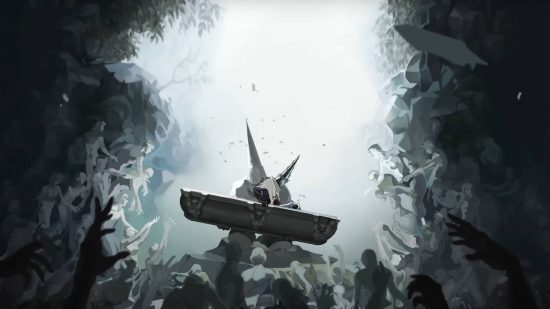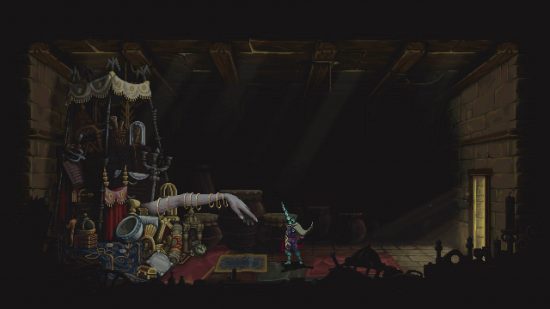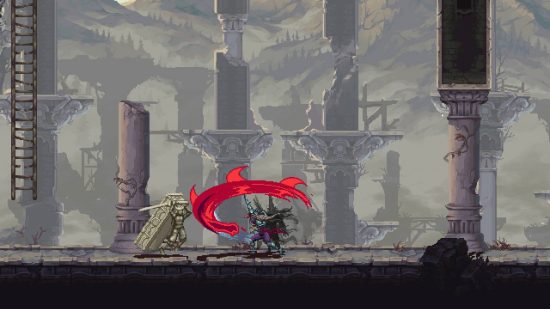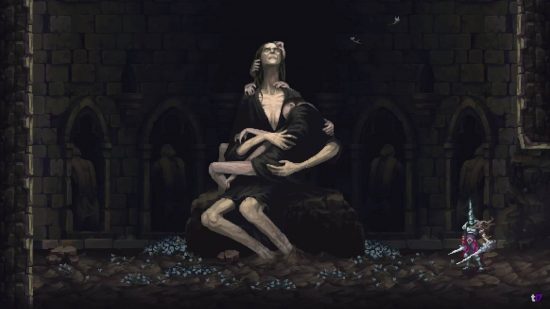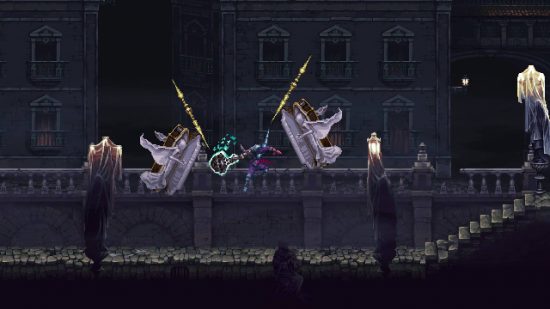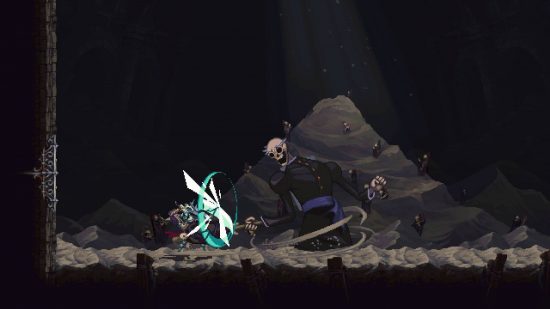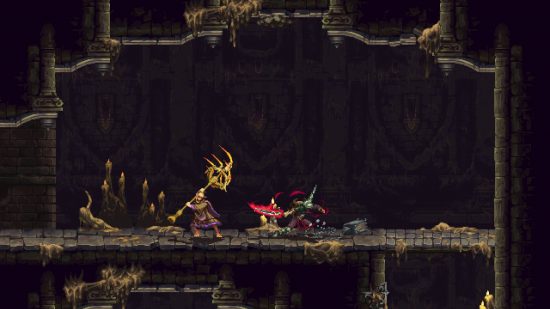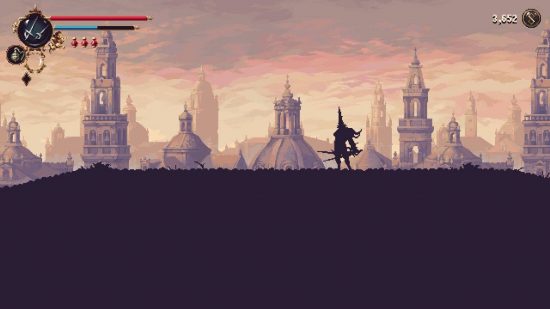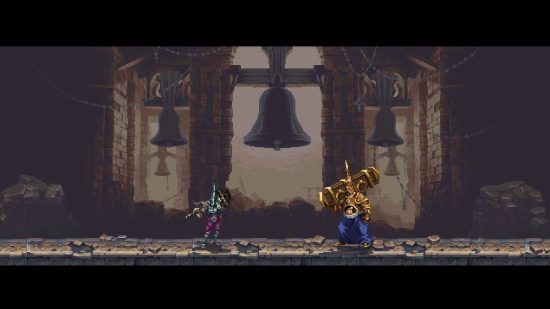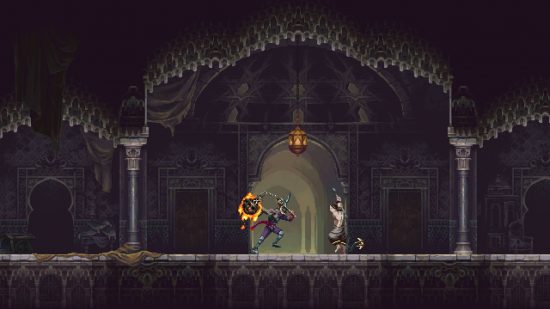Our Verdict
Blasphemous II crafts an intricate and satisfying world that is only accentuated by the gorgeously gruesome art. The Penitent One feels better to control than ever, and the amount of choice you have over your attacks and abilities compliments the game’s punishing combat brilliantly. Despite some niggles, Blasphemous II is a Metroidvania masterclass and an incredibly confident sequel.
If I need to describe the Blasphemous franchise, I’d say it’s “meticulously macabre.” The journey of the cone-helmeted Penitent One through the nightmare realm of Cvstodia amazes me with its painstakingly precise pixel art, from complicated architecture dripping in religious imagery to the terrifying cast of demons and creatures aching to tear you limb from limb in every single area.
Inspired by Catholicism and the developer’s home country of Spain, Blasphemous as a franchise explores the themes of church, sin, and exactly who the blasphemer is. The original is also heavily inspired by Dark Souls and Castlevania, placing that oppressive church iconography around a world full of secrets, hidden powers, and monsters. But, while the first one leans a little too much towards Dark Souls, it feels like the sequel takes some smart steps toward the ‘vania side of things.
Like many, I struggle with the opening hours of Blasphemous, but persistence pays off, as buried deep under a demanding and deliberate combat system is a rewarding action game that features a world full of horrifying secrets well worth your time to uncover. But now, Spanish developer The Game Kitchen is taking everything that works about the original and has made a sequel that’s even more Blasphemous, in the best possible way.
Blasphemous II picks up some time after the end of the original’s Wounds of Eventide DLC, and once again, the Penitent One wakes up in a strange land plagued with evil and is on a mission to uncover the mysteries of ‘The Miracle’. Neither the setting nor the combat are a drastic departure from the original, but instead subtle evolutions with a richer pool of inspirations this time around.
To begin with, The Penitent One gets to choose from three different weapons in the early stages of the game. A large spiked ball (called Veredicto, which translates to verdict), a long sword (Ruego Al Alba, or the praying blade), and two rapiers (Sarmiento and Centella, and as far as I can tell Sarmiento means a grapevine and/or a tall thin person, while Centella means a spark).
You get ample time to play with each before you make your choice, and it’s clear that the game wants you to play exactly how you would like. To begin with, I couldn’t help but go with the spiked ball, though you do soon get to find the other weapons and expand your arsenal. If you’re a huge fan of the first game, the long blade Ruego Al Alba is the closest to the Mea Culpa, though there are still quite big changes.
Veredicto the spiked ball moves with heft and consequence, though it takes several frames to build up your attack it does unleash a devastating swing. You can also charge it for a more powerful attack, but you must choose your moments wisely, as your enemies have neither patience nor mercy. Plus, you can upgrade each weapon using marks of martyrdom, a resource that enemies drop after battle, or you can find hidden around the world.
The twin rapiers offer quick successive attacks, though they aren’t as powerful as the other two choices. However, the two rapiers have lightning abilities, and you can quickly unlock ways to power up your strikes, as well as unleash a flurry of sharp stabs. If you like to attack little and often, these are your picks.
While I picked Veredicto to begin with, towards the end of the game I found that I’ve been using the long blade Ruego Al Alba more than anything else. Using Ruego builds a meter, and when it’s full you can use the move blood pact to charge the blade with mystical energy. Later on, you can also get these blood pact strikes to regain your health, and the balance of speed and power eventually meant that Ruego is my pick of the bunch. Still, each feels great and has their place against certain enemies.
Speaking of enemies, let’s talk about those bosses. Many fans are quick to compare Blasphemous to Dark Souls, and with long grueling fights, it’s tough not to see why. Your bosses here are screen-filling pixelated monstrosities, moving quickly and without mercy. You must get to grips with combat and movement if you want to survive, and it feels absolutely incredible to slowly but surely understand it all.
The changes to weapon types mean that, for me, I don’t find Blasphemous II easier, but it’s certainly more forgiving. Save points are much more plentiful, so you don’t have as far to go as in the previous game, and even just the amount of choice in combat makes things a little easier to swallow. You can block and parry with Ruego, or you can simply smash huge damage with Veredicto.
It’s all well and good that fights feel great, but the design and attack patterns are also so good throughout. The Game Kitchen has really stepped things up, and each boss offers something different and terrifying. There’s one mid-game fight that is a great little nod to Ornstein and Smough, and one ocean-adjacent enemy continues my favorite trope, which is when you fight an enemy a little bit at the start, only to finish the fight at the end of the area much later.
Each fight is a challenge, and you’re going to get stuck. These are demanding but satisfying fights that ensure you pay attention to attack patterns, your weapons, and the different elemental properties of eac magical attack and weapon. But, when you nail it, defeating a boss offers that incredible thrill that few games can offer. Persevere, and Blasphemous II will reward you.
Another striking change comes in traversal, as it’s evident that The Game Kitchen listened to complaints about the original game’s movement. While the first title’s combat is slow and deliberate, and that defensive style works for a Dark Souls-inspired 2D game, the accompanying movement does drag down exploration.
However, while in Blasphemous II, the Penitent One still feels weighty, and actions have satisfying consequences, here, the protagonist feels more agile. The change seems to be a mixture of new moves found as you explore, as well as the quicker attacks on each weapon, but Blasphemous II definitely feels like a much better balance of satisfying action and quick exploration.
It’s not quite the lightning-quick speed of an Ori game, but every action feels more exciting to command. Plus, there are secrets and collectibles in every possible inch of the world. There are puzzles tucked around that use the environment, and they also use one or a combination of your three main weapons. You decide on your first few hours of gameplay with your initial weapon choice, and it’s incredibly satisfying slowly finding the remaining two only to play around with their attacks, but also to discover how they affect the world.
The weapons aren’t the only way you interact with the world either, as you slowly find other abilities that change how you explore. Much like any good Metroidvania, you are soon unlocking shortcuts that combine different areas, kicking down ladders to save you time when returning to surroundings, and even discovering tunnels or passages very cleverly tucked away. There’s a map, so it’s not a huge surprise like some of the reveals in Bloodborne, but it does always feel really good to slowly chip away at those rooms you couldn’t reach earlier.
However, I have one minor issue here. Perhaps I’m too used to Castlevania games like Aria of Sorrow and Symphony of the Night, but I often felt myself missing a leveling system. The combat in Blasphemous II feels better than the original, and whether it’s cash, or the occasional marks of martyrdom enemies drop, there is generally a reward to battling.
But, in the second half of the game things change. At the beginning, enemies block your path, and you are desperate for money and marks, so it makes sense to battle and defeat everyone. Later on, though, you’re agile enough to avoid a lot of attacks, and there comes a point where money just isn’t an issue.
When you die, the Penitent One returns to the nearest save point, with a bit of his magic gauge taken until you return to the point of your death and reclaim it. If you’ve played Hollow Knight, it’s that system. In the later hours, I just found myself so eager to explore that I stopped attacking enemies, and instead got in the habit of using abilities to dart around them. Whereas, a leveling system would incentivize me every step of the way, and the combat is so good I want to be using it.
I know it’s a minor complaint, and it’s silly to say that the combat is so good yet I’m often avoiding it, but there are so many collectibles to find, areas to uncover, and large new biospheres to try and explore. I would just personally prefer to slowly gain experience from battle, especially as you can find chalices and other items around the world that improve your health and your recovery flasks when you return to town and give them to the appropriate vendor. I’d rather be doing this incrementally along the way.
Blasphemous II has a hub town of sorts, with several shops and points of curiosity to return to. A few of these make sense to have there and are fun to occasionally tinker with. But there are just a couple too many NPC characters you have to visit to improve your abilities. Plus, you have to trawl through text menus to find out if one of your items is the one you need. I’d quite like it if when you visit an NPC, they automatically pick up on the fact you’ve brought them the appropriate collectible.
These are small quibbles and don’t really get in the way of the fun, though. And it’s nice that you can customize The Penitent One in many ways, with rosary beads offering on-the-fly changes to stats, the alterpiece of favors offering badge-like boons you can change back in the base town (much like Hollow Knight’s badge system), and you also have access to two magic attacks, one quick verse, and a larger attack called a chant.
Your magical abilities have a wide range of abilities and also utilize the elemental system you have to get to grips with. You can imbue your magic attacks with different properties like lightning, fire, miasma, and mystical. Needless to say, you are going to have a much better time if you learn how to properly utilize your enemy’s weaknesses, and it’s a really nice compliment to the main weapon system.
Essentially, it’s really satisfying to slowly add to your huge range of abilities and unlock shortcuts, allowing you to explore the world with ease. But, Blasphemous II makes almost every single incremental improvement tied to an NPC, and while I love their design, there is a little too much returning to the hub town when I want to be exploring. Again, it’s a small quibble, but it feels like a way to pad the run time, when I’d prefer a leveling system instead of constantly darting back to the city.
Now, back in compliment town, the graphics maintain that stunningly detailed pixel art and dour horror influence, but the actual design feels slightly brighter and more legible when you compare it to the first Blasphemous. The world of Blasphemous II uses splashes of color to accentuate both the architecture and monsters, but also to better demonstrate the visual design of the levels. Which is great because you want to explore every inch of this incredible world.
Clearly, the original pulls passionately and generously from religious architecture and horror paintings, and comments from concept artist Juan Miguel López Barea reveal the sequel has a bigger focus on the more gruesome works of artists such as Francisco Goya. It’s evident throughout Blasphemous II, as certain discoveries reveal huge and stunningly realized painterly pixel art scenes, incredibly well adapted from the beautifully gruesome art of the team.
Some of the large pixel art animated cutscenes are absolute show-stoppers. I find myself gawking at the beauty of these large intricate scenes, as well as the bloody and twisted limbs of so many enemies. It’s astounding that this pixelated style continues to feel so viscerally gruesome, and I can’t convey enough just how gorgeous the design and animation is throughout.
Each and every hour of gameplay features new enemies to find (with a few palette swaps, though they often have different attacks), and each time I can’t wait to see just how this new foe moves. The armies of evil you encounter move with a ghastly sense of energy, as if ripped straight from a zombie movie like 28 Days Later. It feels like the enemies of Symphony of the Night with a Goya makeover, alongside a hint of John Carpenter, and I absolutely love them.
Tying all of this together is a fantastic soundtrack that carefully darts between that Spanish influence with energetic instrumental tracks, while underscoring it with a continued sense of dread. Each area’s themes feel unique, and when combined with the twisted squelches and shrieks of enemies, this world feels so painfully and beautifully alive. I’m going to need a vinyl copy of this score, as each music track conveys the sadness and beauty of its accompanying fight or level with a powerful and almost playful sense of horrifying fun.
On Nintendo Switch, Blasphemous II is running at a silky smooth 60 fps. Fights feel fluid, and traversal feels great, and I’m so happy that Nintendo users get the same experience. I ran into a couple of instances of screen shaking, and occasionally it feels like the aspect ratio changes a tiny amount when in certain menus or between screens. But these are small issues that I’m sure The Game Kitchen will address, and they do not spoil the fun.
Overall, Blasphemous II feels much more like a Metroidvania than its predecessor, with a world begging for you to explore it. Plus, while there are some improvements to combat, I think the changes to its speed, as well as the adjustments to traversal, mean that every moment of gameplay feels much more exhilarating to pull off. The fights are still brutal, and the world is still a painstakingly detailed pixel art masterpiece.
Fans of the original are in for an absolute treat, as Blasphemous II has only sharpened its blade. Compared to the original, Blasphemous II feels easier to navigate and understand, but combat is as tough as ever, just with a few new tricks. The Penitent One’s sophomore journey is a Metroidvania masterclass, balancing incredibly satisfying combat with a huge, rich world full of fantastic characters, enemies, and abilities. Every discovery is a satisfying, if often horrifying, new thrill.
There’s a little too much backtracking, especially as you attempt to increase your abilities with a huge amount of quest items, but save points are plentiful, and Blasphemous II is a gorgeous world I am happy to explore while decimating terrifying enemies with the vengeful weight of Veredicto by my side. This is a confident sequel that improves upon almost every aspect of the original, and I’m aleady praying for Blasphemous III.

If this has got you in the mood for more platforming adventures, be sure to check out our guide to the best Switch Metroidvanias.
